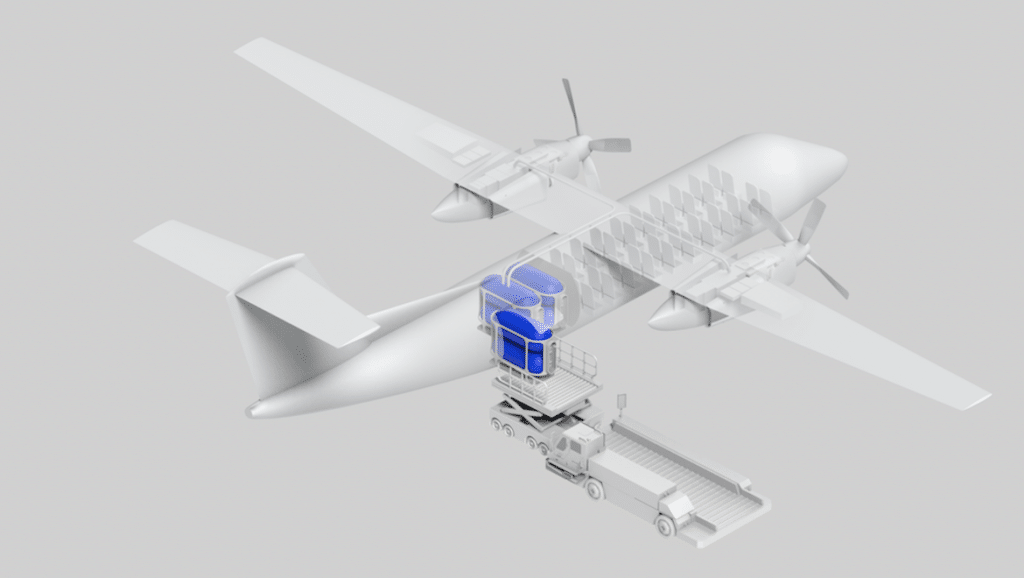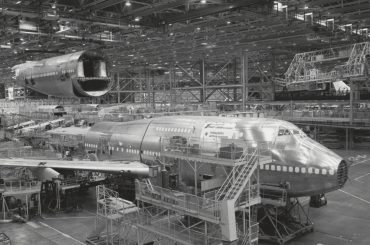
Universal Hydrogen, a California-based start-up co-founded by former Airbus chief technology officer Paul Eremenko, has launched plans to convert regional airliners to hydrogen power.
The company said its business model will encourage early adoption of the carbon-free fuel by the air transport industry before manufacturers develop new aircraft with hydrogen propulsion as standard equipment.
Eremenko and his fellow founders maintain that hydrogen is the only clear pathway for aviation to achieve true carbon neutrality and the complexity of the required infrastructure remains the key obstacle to its widespread adoption.
Formed seven months ago, Universal Hydrogen recently publicised a plan to re-engine Dash 8 and ATR 42 regional airliners with fuel-cell electric propulsion and refillable hydrogen modules.
The modules will be supplied directly from hydrogen production facilities to the aircraft. The company is offering to cover all or part of the conversion kit costs for the new propulsion system in return for long-term contracts to supply the hydrogen.
According to Eremenko, it would be far too capital intensive to supply hydrogen in the same way that Jet-A supplies reach aircraft today, via ships, pipelines and fuel trucks.
“Infrastructure is the main problem, and the solution we’re building is a capital-light approach to delivering hydrogen to any airport in the world,” Eremenko said.
Universal Hydrogen’s response has been to treat the fuel as dry freight and find a safe, efficient way to maintain supply to airlines.
Its modules, which measure about seven feet long and three feet in diameter, can carry the hydrogen in liquid or compressed gas form to be loaded into the back of the aircraft via standard cargo loading equipment or a forklift.
According to the company, aircraft of the size of the Dash 8 or the ATR 42 will offer a 400 nautical mile usable range (allowing for reserves) with compressed gas hydrogen or 550 nautical miles with liquid hydrogen.
That means they would be able to serve, respectively, about 75 per cent and 95 per cent of the routes now flown by those aircraft models.
The hydrogen modules will be loaded into the rear of the aircraft and placed in a compartment that will replace the last two rows of seats.
That will reduce capacity from around 50 to 40 passengers, but Universal Hydrogen said the cost to fly each seat a given distance will stay the same.
Plumbing lines will run from the modules through the aircraft’s dorsal fins into each of the two nacelles where fuel cells and electric motors are installed to power the existing propellers.
Essentially, the hydrogen modules take the place of batteries in the electric propulsion system.
On 15 September, electric power pioneer MagniX announced that it will partner with Universal Hydrogen to provide a pair of 2 MW electric propulsion systems for the conversion kit.
The Washington state-based company is already working to develop electric-powered versions of the Twin Otter and De Havilland DHC-2 Beaver. Canadian regional airline Harbour Air plans to replace its fleet with the electric Beaver models.
Universal Hydrogen said that the additional weight of the fuel modules will be mostly balanced by the removal of two rows of seats and that the modifications to the fuselage and powertrain will not result in an increase in the maximum take-off weight of the aircraft.
As part of the supplemental type certificate process for the conversion, the company will have to complete drop, burst, and vent tests on the modules.
From extensive testing by NASA and in the automotive industry, it is well established that gasoline is far more explosive than hydrogen, which burns quickly and rises from the point of ignition rather than engulfing the vehicle.
Universal Hydrogen’s business model calls for it to license the conversion work to approved maintenance, repair, and overhaul providers.
The work would typically happen during scheduled major maintenance on the aircraft. The company estimates that more than 2,200 regional airliners suitable for conversion exist worldwide.
The company believes it can get the first converted aircraft into commercial service before the end of 2024. In the longer term, it is looking to partner with aircraft manufacturers to provide its hydrogen propulsion systems as forward-fit on new aircraft.
“In the late 2020s, Boeing, Airbus, and Comac are all going to make decisions on their new single-aisle aircraft and there is a real possibility that these could be hydrogen-powered,” Eremenko said.
He said that he co-founded Universal Hydrogen because he does not see major aerospace corporations rapidly pioneering major shifts in technology, like hydrogen propulsion, because, in his view, their “incrementalist mindset” impedes progress.
Since late 2019, Airbus has increasingly signalled its intention to pursue hydrogen propulsion, perhaps in part as a result of what it has learned from testing the battery-based Vahana and CityAirbus eVTOL technology demonstrators.
Eremenko sees hydrogen production capacity expanding fairly rapidly around the world. Producers make the fuel through a process of electrolysis that separates hydrogen and oxygen in the water.
The Los Angeles-based start-up funded itself with some US$3 million and drew another US$2 million in contributions from undisclosed partners. It estimates it will need to raise in the aggregate about US$300 million to meet its goal of the first converted aircraft entering service in 2024.
Along with Eremenko, the other co-founders are corporate attorney Jon Gordon, John-Paul Clarke, an aeronautics professor and a former vice president of strategic technologies with United Technologies, and Jason Chua, the new company’s COO, who also came from United Technologies.
Article courtesy of Airlinerwatch











